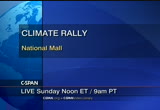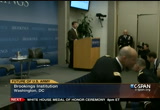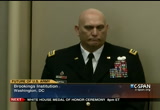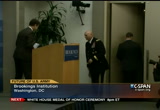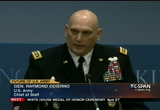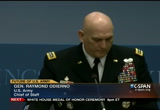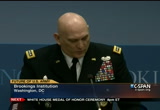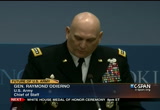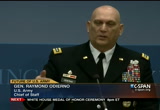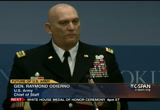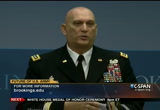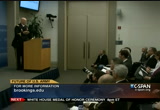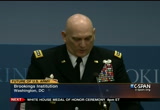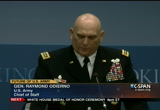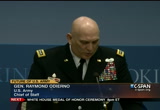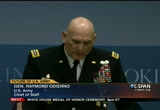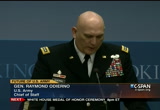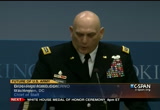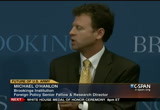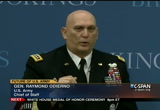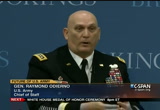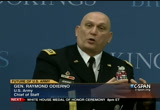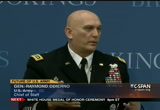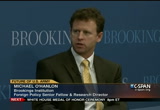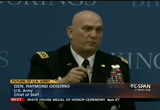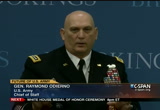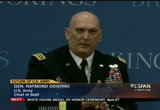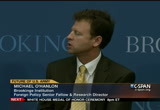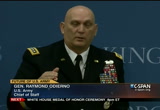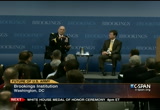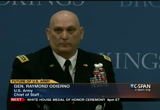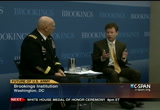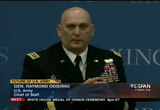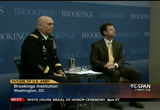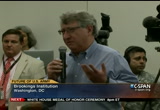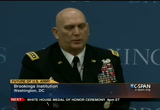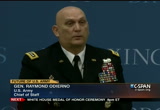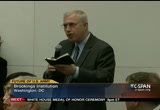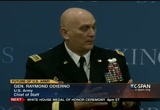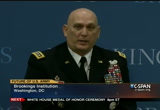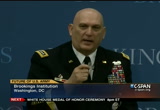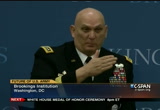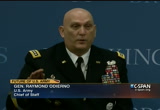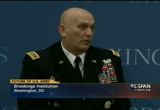tv News Politics and Public Affairs CSPAN February 16, 2013 7:00pm-8:00pm EST
7:00 pm
most of them will be mobile. if you are in your car, it will be mobile. we need this spectrum as being more related to the need for more videos are youtube downloads. in reality, that is not what we should be thinking about as a society. it is more like the healthcare policy. it will be mobile. it it is mobile, you need spectrum. >>this is the communicators. on location in las vegas at ces international 2013. more programming next week. >> on the next washington journal, a round table with
7:01 pm
david winston and democratic strategist steve mcmahon. then a discussion on cyber security with the president and ceo of internet security alliance. and the president of the plow shares fund talks about north korea's nuclear program and his book, "bomb scare." washington journal, live at 7:00 a.m. eastern on c-span. tomorrow, live coverage of the forward crime rally on the national mall here in washington. speakers include a vote by the senator sheldon whitehouse, van jones and representatives from the sierra club. our live coverage begins at noon eastern here on c-span. >> i think the women in many cases were interested in politics but have no vehicle to
7:02 pm
express that in their own lives. so they were attracted to men who were going to become politically active or war already politically active. >> each of them i find intriguing. probably half of them precisely because they are so obscure. historically. half of these women probably would be almost totally unrecognizable to most men and women on the street. >> is president day, the new series first ladies, influence and images. with historians, chief of staff, social secretary, chefs and curators exploring the lives of women who served as first lady. in a first of its kind project for television. season one begins monday night at 9:00 a.m. -- at 9:00 p.m. eastern and pacific.
7:03 pm
>> u.s. army chief of staff general raymond odierno says the greatest threat facing our nation is the fiscal uncertainty and potential budget cut -- but it sure call. hort falls. he made these remarks at the brookings institution. this is just over an hour. >> good morning, everyone, and on behalf of brookings and our center for 21st century security, we're honored to have the chief of staff of the army, general ray odierno, to speak. you are aware of the challenges of the budget process and our future military planning as well as current operations. no one could be more distinguished and a more
7:04 pm
thoughtful person to discuss these matters than general odierno, who is a friend of brookings and the broader defense community for a long time, and he has been a distinguished servant in our nation's military and defense throughout that time. he took the fourth infantry division to iraq and presided over its operation, directed its operations in the first year of the iraq war. then he returned as the multinational force corps commander and was along with david petraeus and ryan crocker one of the key three american architects of the surge. from december 2006 through the early time of 2008, he was the person making the decisions on where the forces should go, how they should base themselves, how they should operate within the population, how they should interact with iraqi forces, all the detail behind the surge, that if you speak to general
7:05 pm
petraeus, he will say that is the crucial part of what made this whole thing work. general odierno was the primary architect. he got a few months off and went back to iraq, commanding the entire operation, where he did the job for two years and did not get any reprieve, because after spending a year at the joint forces, he has been the chief of staff of the army since 2011 and is engaged in this intensive budget process right now. we all look forward to hearing what he will say. he will speak for a few minutes. i will ask a few questions appear, and then we will go to you. please join me in welcoming general odierno. [applause] >> thank you very much. it has been a pretty exciting week, but there are many more
7:06 pm
exciting weeks ahead of us, i believe, and i look forward to those. i appreciate everyone coming out today. many thanks to michael and everyone here at brookings. it is always a pleasure to come here. it is an opportunity to think through the difficult issues and get a chance to listen and hear other people's opinions. i look forward today to answering your questions. i will leave a lot tougher questions, so i can discuss the issues that you think are important, that you want to hear about, but there are a few things i want to say first, so i will take 10 minutes to talk about that. as i said, your invitation to speak is a timely one, as we testified twice this week. we have the state of the union address as well this week, as well as for me the presentation of the medal of honor for staff sergeant romesha.
7:07 pm
those things come together when you think about the president talking about how he sees the future, we have us talking about the future of our budgets, and what it means to our defense, and then we have the opportunity to see a great american hero, a young soldier who does what we ask him to do every day, and so it has been a very emotional and important week for me personally, as evidenced by the congressional testimony this week, our nation's leaders continue to grapple with decisions that will shape the trajectory of our national security for the years ahead. the near-term budget decisions ahead of us today will affect the direction we're try to take the joint force, but in my case, the army, as we complete combat operations in afghanistan, then reset our equipment, reorient our force and be prepared to deal with a broader weight of challenges that are defined in the defense
7:08 pm
to strategies that we rolled out last year, when we put a lot of thought into about where we want to go as a defense department in the future. we need to approach these problems, as tough as they are, with an understanding of the fundamental role the army plays in providing our nation's security. this morning i would like to describe the strategic and physical challenges that the army faces, the joint force faces, and the impact it will have on the future, to include its readiness, size, and other things as we move forward. before i do, i would like to take a moment to reflect on the basic building blocks of the army, and that is the american soldier. and staff sergeant romesha was presented the medal of honor by president.
7:09 pm
his heroism symbolizes the caliber of the men and women serving today. it's hard to give credit to the american people just how talented and dedicated these young men and women are. they possess humility and selflessness that we will respect. they embrace and are dedicated to the profession with moral and physical courage that epitomizes the american soldier. since 9/11 we have grown a generation of leaders and soldiers from the young men and women who have volunteered to serve our country. 1.5 million soldiers have deployed over the past 12 years. more than 500,000 have deployed two, three, four, or five times. more than 4700 have made the ultimate sacrifice to defend this great nation.
7:10 pm
our soldiers today operate in a most uncertain and unpredictable environment. it is the most dynamic and unpredictable i have seen in my over 36 years of service. unlike post-conflict drawdowns, where we have a termination of conflict due to a police treaty or a political decline of a superpower, instead today we have 81,000 soldiers deployed, including 50,000 fighting in afghanistan, and thousands of others in kuwait, in the horn of africa. over 91,000 soldiers are stationed in over 160 countries. we have been in a continuous state of war in the last 12 years, the longest in our history. but today, in my opinion, the
7:11 pm
greatest threat to our national security is the fiscal uncertainty resulting from a lack of predictability in the budget cycle, a series of continuing resolutions, a threat of sequestration hanging over our heads, our country's inability to put its fiscal house in order compromise is the full readiness of the joint force, army, and will impact our ability to provide our security to our nation. we have two problems as i sit here today. we have an immediate problem in fiscal year 2013, which has about eight months left. we have a longer-term problem due to potential full sequestration. in fiscal year 2013, the combination of a continuing resolution, a shortfall of overseas contingency afghanistan funds and the sequester has resulted in a $18
7:12 pm
billion shortfall to the army's operation and maintenance accounts, as well as an additional $6 billion cut all other programs. all these cuts will have to be taken over the last seven months of this year. what does that mean? what that means is we will have to take immediate actions. as we prioritize, we will always ensure that our soldiers in afghanistan or next to deploy are properly equipped and trained. then we will see if we can continue to ensure the readiness of the global response force at fort bragg. we will have to take some immediate steps to reduce expenditures and plan for budgetary shortfalls. we will curtail training for 80% of all our force. we have canceled all but one of
7:13 pm
our brigade level training center rotations for non- deploying forces. training camp cuts will impact our fighting skills. it will reduce shortfalls across other specialties, including aviation, intelligence, engineering, and our ability to recruit new soldiers into the army. we will reduce work at our depots, which will delay the reset of our equipment coming out of iraq and afghanistan. we will furlough up to 251,000 of our civilians for up to 22 days, terminate nearly 31 employees, and 5,000 workers at our depots. and the list goes on and on. i am touching on just a few of the impacts that will cause us to make some of these difficult decisions over the next seven months, because of this bermuda triangle of uncertainty that we have had in the budget, specifically in fiscal year 2013.
7:14 pm
in the longer term, we have a bigger issue. i want to first remind everybody that sequestration is not the first cuts we have taken in the military. in 2010, we took $200 million in cuts on the secretary's issues, followed up by the budget control act which directed another $487 billion worth of cuts in our defense spending. we are now just beginning to implement that almost $800 billion worth of cuts now. we have not quite seeing those that. we have just begun to see the impacts. on top of that, with sequestration, we will take an additional $500 billion worth of cuts in the department of defense, so we're now up to $1.2 trillion worth of cuts since 2010.
7:15 pm
this does not include the reduction in our spending of overseas contingency accounts, which also now has to be -- some of it will have to be woven into our base budget, such as ied detection equipment, which will cause another shortfall in the department of defense as we migrate these programs that we know we need in the future. we're now up to $1.3 trillion worth of cuts, which we will have to find in the department of defense. this is significant. people often say afterward we have a reduction that is normal, in the army. since 2008, if we implement the 2014 budget without sequestration, it will be a 45% reduction in the army budget. if we implement sequestration, it will be over 50%. that is a significant cut.
7:16 pm
these are not insignificant numbers we're talking about. it will have an impact on our capabilities as we move forward. for fiscal year 2014 and beyond, sequestration will result in a loss of by a minimum 100,000 soldiers in our active national guard and u.s. army reserve. this is on top of an 88,000 cut we're taking right now. my guess is -- that is about 190,000. i guess in the end it will be over 200,000 soldiers that we will have to take out of active components of the national guard and the u.s. army reserve. we will take almost a 40% reduction in our current brigade combat teams once we're finished. sequestration will result in delays of every one of our modernization programs, stretch them out longer and longer. it will have an inability to reset our equipment in a timely
7:17 pm
fashion if we are asked to deploy, and it will impact our ability to train individually the units. these reductions will impact every army base at installation across the entire country. such a rapid decline in our ability to train and maintain the force will result in extremely low levels of readiness inside the next six months, which will cascade into fiscal year 2014 and 2015. no matter how this all turns out, which is still somewhat of an unknown, fiscal constraints are here to stay. we understand that. we have to play a role, because the status of our economy and our fiscal capacity is a key piece of our strength and a nation, and we understand that. but our domestic fiscal constraints do not diminish budding threats overseas.
7:18 pm
many of the challenges we face are in headlines at every day, whether the aggressiveness of north korea and iran, the proliferation of weapons of mass destruction, continued turmoil across the middle east and north africa, or with a growing threat of cyber attacks. as a joint force and an army, we must make decisions based on the context of the security environment and the historical experience, not false assumptions about the future. last year the department of defense to build a collaborative process to publish a 2012 defense strategy. the strategy calls for on the department to invest in the capabilities critical for future success cannot resist the temptation to sacrifice readiness to retain force structure, rebuilt readiness in areas that would be emphasized over the past decade.
7:19 pm
a fundamental role in 10 of 11 identified missions, the army designated its force structure requirements in support of this guidance. my priorities for building the army of the future have not changed, because they have been developed from consistent with our new defense strategy in how we see the future. if sequestration occurs, we'll have to do a complete review of our defense strategy. and develop a new strategy based on the fiscal realities. as we move forward, the posture for our army in the future, we must have the foundational capabilities to win our nation's wars, but more importantly, we must provide capabilities to our geographic combatant commanders that assist in their efforts to shape there and start to join inter-agency and multinational activities, what we call phase-zero operations.
7:20 pm
we'll have to harness the unique capabilities of the army and sure that the combatant commanders get what they need to -- their environment, we will deliver packages for a variety of missions such as building partner capacity the humanitarian and disaster relief, bilateral exercises, and rotational forces for operational contingency missions. we will execute this by implementing a process of what the called regionally allied forces, where we will align the army to meet their needs. some additional actions we're taking to reshape the force, but include making modifications to combat team structures to incorporate the lessons learned of the nearly 12 years of war. we must revitalize our military education system to ensure we are growing leaders with a broad understanding of historical experiences, but more importantly, to prepare them for the future, to prepare them for what we expect to see as we move forward.
7:21 pm
it is more important that we seek a balance of capabilities and readiness across the total army. we need the capabilities of the active army, the capabilities of the army national guard, and the u.s. army reserve. we must balance our force structure to reflect the different readiness levels of each of our components, and make sure they fit into the strategy that we will execute into the future. we must make it affordable and cost-effective decisions to provide the most professional capabilities to our commanders, and we must capitalize on our strengths. our modernization efforts must remain centered on the soldier and squad as a building block of our army. the extent to which we provide
7:22 pm
our soldiers the right equipment, vehicles, and that works to succeed of future battlefields will be determined by our fiscal decisions today. we must learn from our 12 years of combat to build and sustain the resiliency and readiness of our soldiers, civilians, and families. we will watch campaigns to develop a comprehensive fitness and stress that our force. we will place a high priority of programs that help veterans and families transition back to civilian life. caring for our wounded warriors and keeping faith with families is the century to honoring their service and preserving america's confidence in our military institutions. we are at a strategic point in the future of the u.s. army and the u.s. military. there's no doubt that we need a globally-engaged army with enough capacity to deter and prevent conflict. we need an army that takes
7:23 pm
capabilities and the unique structure that army has today to shape the environment and prevent conflict in all of our geographic combatant commands. this is about our nation's security. it is about developing the right balance of capabilities within the joint force. our history tells us that we get out of balance, our enemies will seek to take advantage and use that calculation in conflicts. the one thing history is clear about, we will be asked to deploy soldiers again. it is my responsibility that when they are asked, they have the capacity and readiness to be decisive and accomplish the mission. i look forward to the debate and feedback on the joint force and army's plans to posture for the future. i am interested in your views on the effects of budgetary effects and sequestration and its impacts on readiness and our national security.
7:24 pm
7:25 pm
>> thank you for your moving remarks and the big issues you are wrestling with. i wanted to come back to specific points to give you a chance to elaborate. let's begin with the $18 billion number you mentioned, a scary number. some people in this audience follow the nitty-gritty of defense more than others, but would you explain what that means. let's talk about that number. the $18 billion is in your operations and maintenance account, which is paying for everything from the civilian work force to health care, training and maintaining the equipment, getting ready for war. you said you are going to protect the funds in that account for those who are already deployed or how are about to go, which means the rest of the force has a larger cut. can you explain this in more context in terms of what percentage cut this might be or the kinds of things that these forces normally would be doing in the spring and summer they will not be able to do this year. >> what that means is there is a couple of factors happening here.
7:26 pm
the army is responsible for funding the afghanistan operation, so we won't allow our mission in afghanistan, our troops, in afghanistan, to go unfunded. we have been given the authority to do that. we will not let that go unfunded. we see about a $5 billion to $6 billion shortfall, and we think it might grow to as much as $8 billion. so that is a problem. when they signed the continuing resolution when that went into effect, there was a mismatch of funds, not enough funds in the operational accounts, so we have a $6 billion shortfall there, and the sequestration adds about another $5.4 billion. what does that mean? we are funding totally afghanistan. we are going to fund totally korea to sustain their readiness level in korea. so what that means is the rest of the forces now back in the united states will not be able to train, not be able -- they will be able to do small-level, squad-level training, not
7:27 pm
platoon-level, company-level, the kind of training back at their installations. they will not be able to go out to combat training centers, which is what provides them the final readiness certification at the battalion and brigade levels. what that means in the future is we are funding the forces in afghanistan and the next ones to go in, and as they go in in the summer and fall, my concern is the ones that go in after them, they will now be behind, and we will have to extend, when 2014 starts, how long it takes me to get them ready. i made the comment to congress the other day -- i have two choices. if i cannot make that up quickly, i have to send in forces that are not ready, or i will have to extend those already there, and that will be a decision i will have to make as we get closer, and we will
7:28 pm
continue to try to divert money so we do not have to extend people in afghanistan, and that is a big concern of mine. it impacts many other things like installations. this runs our installations. we are going to have to cut 70% of the money we have available to run our installations so we are going to be able to pay for water, heat, and that is about it -- and air conditioning, depending where you are. we are -- we are not going to be able to do maintenance on facilities. this means is when we get the money, it will cost us more, because we will have delayed the maintenance of our buildings, of our training systems, of all the other things that are run on our installations. we have tried to protect our critical family programs that are needed, counseling and other things, for families and soldiers who need them. that also will be impacted somewhat. it will not be completely protected. so this has a dramatic effect on our ability to train and provide forces in the future, has a dramatic effect on our installations, on our families.
7:29 pm
it goes across the entire army, and as part of this we will lose part of our civilian workforce, our depots will be smaller so the backlog of our equipment coming back. we are still resetting equipment coming out of iraq last year, and that will take another while. that will delay that. it will delay the equipment coming out of afghanistan, so that decreases readiness levels, and that continues to build on itself, so instead of being ready by 2014, now it might be 2016. my concern is because of the uncertainty in the world, we do not know when we might have to go somewhere. nobody knows. 36 years in the army, but i will take the last -- since 1989, or 1990, we have not predicted when we will use forces. when the wall came down in europe, people said this is it,
7:30 pm
we do not need any more, and a year later we are deploying to the desert of kuwait. then we went into somalia, and then we had panama, so you do not know. it is our responsibility to be prepared that if the president decides he needs to use the military, that we are ready and prepared, and i am concerned whether we will be able to do that as we move through the next couple years. >> give us a picture of what happens now with equipment that needs to be repaired. helicopters, tanks, other vehicles, what happens to them over these next few months? >> we have two kinds, tanks, bradleys, fighting vehicles, helicopters, and motor pools, so over the next seven months, those not deploying, we will not be able to sustain them to the
7:31 pm
level that we normally do. people have to do some minimal- level maintenance that we can afford to at least do something, but it will not sustain them to a level necessary for us if we have to deploy them. what i have tried to describe is today we are in a high state of readiness, but that goes away, it slowly degrades, and so over the next six or seven months, if you are not taking care of your and equipment, you are degrading your equipment. you can never gain back that tide. used parts push readiness to the right. but some people will say putting some fiscal pressure on dod is not such a bad thing overall. is anything that the services
7:32 pm
are embarked as you face the reality, any good at all? maybe you could quantify what percentage of the cuts you might have to take are actually reasonable to consider? is there any good? >> there is, so what happens anytime you are in war for a long time, 12 years, and it has happened in the past, is because of our attempt to react and make sure we have everything necessary for our soldiers, sailors, marines. we spend a bit more money on providing that, and it is not as efficient. there are inefficiencies that we can gain. the efficiencies we need to gain in training, there are efficiencies we need to gain in our acquisition systems, there
7:33 pm
are efficiencies we need to tighten up on just normal management techniques, and we are doing that. that was part of the $300 billion that secretary gates tried to start when he started this. we're not saying which cannot any more cuts. we are trying to lay out to everybody that we agree to take about $800 billion worth of cuts, approximately 300 billion when secretary gates presented it, the $487 billion we agreed to, and those are based on downsizing, getting more efficient and providing a force that is more effective. adding on to that will cause issues, so we understand, but i think people think it is only 10% of your budget. again, if you look at numbers and what it really means, it is much more than 10% over time, and it is critical to us as we move forward. for the army, about 48% of our budget is people. if you want to reduce costs, you got to reduce people.
7:34 pm
there are two sides to this. i got to balance that. one thing i promised i would never do is have too many people where i cannot sustain them at the right readiness levels or give them the best equipment. i am not going to walk away from that. but you have to be careful of is if you get too small, i believe you lose your ability to deter conflict. my concern is what you -- you have people miscalculate, and almost every grade or we have been in the mud great regional conflict, is based on a huge miscalculation by somebody. what i worry about is we will cause people to miscalculate which will cause us to have to get involved. we want to maintain the right capacity that people understand that we still have the ability to respond and still have the ability to ensure our own security for our nation across the broad support some of our joint capabilities.
7:35 pm
>> another question, but i want to come back as we near the 10th anniversary of iraq, do you have reflections on that important anniversary? before i do that, i wonder if you could explain the last point about cutting the army and what signals and might send, and my question is, the army could get smaller, and you have been clear, you're making it smaller already, it is already going back close to 1990's levels. in the cold war period, it was around 800,000. we might have cuts of 400,000 active-duty soldiers. is your major concern that that is way too small of a force, potentially, or that the pace that we would get sends a message that america is retrenching? are you worried about the actual number or the sum total of all these messages we are sending? >> both.
7:36 pm
first, we realize the army is getting smaller, so we are going down to 490,000 of the active component. even if sequestration does not occur, it will still go down. we're still working that number. if we get sequestration, i got to be careful we do not go below a certain number, and it has to do with capacity and capability. we have to work our way through that. in the first round of reductions, we did not reduce the national guard or the reserve. we some people off, but no force structure. they took all their force structure. sequestration, we will have to do it with balanced cuts, so we maintain that balance, because the active component brings certain qualities, the qualities are they are at a high readiness level, prepared to deploy quickly, they have the
7:37 pm
capability to do certain things quicker, but the national guard and reserve board also have a huge quality that we need, a diverse level of experience, in certain areas we cannot live without, a depth that allows us to conduct operations if we have to have extended operations, that are key, and they provide a key role in homeland defense and security. i have got to balance to make sure we keep that right balance. it is not one or the other, it is about the right balance between the two, and that is what we're working through. that is what i hear arguments, this one is cheaper than this one. i do not listen to that discussion because it is about the right balance of capabilities to what we expect our national security to need. there is a reason we have the guard and reserves, a reason why it is more expenses, there is a reason why they are citizen soldiers come and we need that.
7:38 pm
there's a reason why we need an active component, and i got to make sure we balance the back. i worry about the size as well. i think there's a certain level of capability that i need to have, that i would propose to the president and to the chairman and others, that we have to have come in order to sustain our capabilities to respond globally. i think you have to be careful. is it 490,000? we might have to go lower than that. some of the numbers i hear are too small. i do worry that the capability will be much less than we need. to get the thing is, what are our partners doing? frankly, as i look at all our partners, except right now for france, we have looked at all our nato allies, they are set to reduce their ground forces. i mean, you cannot say that part
7:39 pm
of our plan is our allies. if their capacity is reducing, we have to be prepared to make sure we can unilaterally do what we need to do to protect ourselves. we have to view that as well as we go forward. >> one last quick follow-up. when you think about the numbers getting too small, the army getting too small, this is will be a question where you say all of the above, but i am curious how would you would at the size, do you think primarily about certain areas? we had a north korean nuclear test this week. we cannot rule out war on the korean peninsula out. their concerns and the president is not inclined toward major interventions. syria, who knows where the conflict is going? there's a potential for a crisis with iran that could begin with air strikes against the nuclear facility, but the enemy gets a say in where the thing ends. there are some areas that are possibility that are hard to roll out definitively.
7:40 pm
is that how you come up with a number that would be too small, or is it the pace at which we get to wherever we are going from where we have been? >> you have to have a certain capacity capability. you can size it against a certain threat, but it how does it react -- is it the kind of capability you want to react in a matter what happens? it is a certain size you need. in terms of how fast we come down, that is important about sustaining the incredible quality that we have today in our army. this is the highest-quality army we have ever had in terms of people and leaders. and so if we try to come down too fast, we have learned -- and we have done this in the past -- we have lost our best leaders and best soldiers. part of this is coming down in
7:41 pm
such a way where we are able to sustain our best leaders, soldiers, and readiness. the problem i have is not only do i have to come down, but because of the uncertainty of the world, i have to sustain readiness as i come down. if you do it too quickly, you are going to lose readiness, and that is a problem we are in right now. we're trying to do this so fast with so many of these forced cuts, if something happens, it is causing us concern because i have to sustain readiness if we have to respond. it is a combination of those two. >> please identify yourself. we will begin in the back in the blue shirt. >> good morning, and i do not want to divert you from this should see the level or from your message, but i would like to take the opportunity of your being here to ask about veterans.
7:42 pm
several years ago i spent time living and working on a small u.s. base in northeast afghanistan. nothing bad happened to me, i came home with no mental trauma or physical injuries to work through, but nevertheless i had a tiny taste of the disorientation that veterans feel. for a couple of days come, i felt like walking up the people as i went about errands and shaking them and saying, do you have any idea what their country are going through for you on the other side of the world? as this idea of "thank you for your service" has permeated to the population in american popular culture, there's something supervision about it, if you pardon me for saying it, even faddish. in your view of how veterans have been received and cared for here, what in your opinion has worked well and what is not working well? >> there are two things we have
7:43 pm
to do, and that is provide long-term care and access to care for our veterans who have had injuries, whether they be visible or non-visible injuries, and they have to be confident and their families have to be confident that there will be there and will always be there. the second piece in my mind is the program, a soldier for life program, and what this means is i believe it is part of our responsibility to help soldiers transition. and that we transition 200,000 soldiers every year, so it is about us helping to transition into society can transition into a job that is worthy of their expertise.
7:44 pm
we have had a lot of companies stepped forward and want to help us with this, and i encouraged by the work, but there is much more to do, to make sure that if you want to thank a veteran, you thank them by giving them the opportunity of employment and give them the opportunity to continue to provide for his family, and to me, those are the most two important things trade some of the things we're not doing well it is taking us too long to get them to the processes to determine level of injury they have had and the right compensation. it has taken us too long to do that, we're getting better, but it is taking us too long. aboutlearning a lot today's society, what are the
7:45 pm
issues of ptsd and its relationship to suicides? i think suicide is a societal issue that is growing, but we have a huge problem in the military. we have to continue to figure out how we get after this. that is what i mentioned at the end of my talk today our ready resilience campaign. we have learned that there are several things we have to do, and we have to start from the beginning when you first come in, is everybody comes from different backgrounds and capabilities, and we have developed resiliency in our soldiers, and we did that with physical resilience, mental resilience, we build mental resilience to confidence and coping mechanisms that allows
7:46 pm
them to deal with difficult such reasons we put them in, as well as their families. we have to be able to do that. i have seen and you have seen -- if the same thing happens to two people, they react in different ways. we have to bring that closer together. >> in the back, two over from where we just were. >> you mentioned briefly syria, and i was wondering the possibility of an intervention happening, maybe yes, maybe no, but is important for people to understand what that intervention might entail and your talks about that. and ground troops, and what is at stake? >> a few things, thanks to the questions. a few things we have to be concerned about.
7:47 pm
one is how politically does syria turn out? >> if you talk to most experts, they will tell you it is not a matter of if, it is a matter of when a new regime takes over syria. what joy we do politically in other ways to support their regime -- can we do politically in other ways to support their regime? the second issue is the of wmd. what happens to the wmd in syria. it is a concern on everyone's part that that stays secured and does not fall into the wrong hands, especially those at terrorist organizations who might try to use it in a variety of ways. as we move forward, we put plans together to make sure we are prepared if asked, if an intervention is required. the president believes he can do most of this diplomatically
7:48 pm
working with our partners. we just have to be prepared if necessary. we will continue to plan, to look at how potentially we might have to use -- we're doing that that on a significant basis every day. >> i am a transitioning military officer. the question for you -- i'm on the market, too, by the way. in light of the reset and orientation and sequestration, what do you want from businesses and think tanks, universities to help you prepare the joint force in the army in the asia-pacific region?
7:49 pm
>> what we need is constant thought about what we think the future of warfare is, and how it impacts. whether it be in the pacific region, in the middle east. it is important to constantly have that thought in discussion. i have been disappointed -- the ground war is over in afghanistan. a lot say, we don't need [indiscernible] anymore. the balance might change. it is about having a force that enables us to sustain our security. there is nothing in history that tells us that we will never use an army again. there's nothing that tells us
7:50 pm
that. there is no historical part of time that says that will be the case in the future. this kind of discussion bothers me. i would like to see some thought into what is the type of force that we need, and how do we as it did have a good solid discussion about it. that helps it -- us think through the problem. technology is still really important. the biggest challenge for the army from a technology perspective is this trade-off between mobility, survivability, and lethality. we found in afghanistan and iraq, because of low-tech weapons we lost our survivability. sorry tom a -- sorry, because we had to focus on mobility. we had to stay on roads.
7:51 pm
from a technological standpoint, we need people to start thinking about this. we need development and materials, we need to develop new ideas and how we can conduct operations and lethal operations. the last thing we talk about is -- leadership is the key going forward. i believe that in the future, it is about intergovernmental multinational environment. it is the ability of her leaders to operate in this environment, -- our leaders to operate in this environment and be able to move through this. what i have learned in the last 10 years is, it is not about what happened. it is about why it happened. once you figure out why it happened, you can come up with the right combination of solutions to fix the problem. we need to think about that. those are the kinds of things.
7:52 pm
>> you, sir, in the fourth row. >> general, thank you for your service. i run a campaign on the importance of k-12 geography education. the campaign has been endorsed i to former defense secretary's, -- by to former defense secretary's. do you think in thinking of the army of the future that the leadership of the education system here in the us is doing enough to prepare students? >> one of the big problems we have right now it's about out of the population only 19% to 23% is qualified to come into the army of a young population. that is terrible. that is about the development of our youth, element across a rod spectrum.
7:53 pm
those who get -- rod spectrum. it is about physical fitness. we have a huge problem with obesity, people graduating from high school. the eligible population is getting smaller and smaller. the army is fine today because there is not as much competition, but as the economy goes, it will be more and more competition for this 19% to 23% percentile. let me talk about geography. the complexity of the world and the fact that you can -- the ability to instantaneously communicate because information has changed the world. it is absolutely necessary for us in the united states to know just more than the 50 states.
7:54 pm
i would tell you that as you get around the world, you have to understand the world and its geography. i am pretty good, but i still struggle with africa because the names keep changing. we have got to understand that. not only the geography, but the cultural, religious, economic aspects. that all contributes to how you figure out what the right response is when you have a problem in a certain area. >> we hope general rodriguez will soon be running africana -- africom. a shout out to the class of 1976. i think that is worthy of a brief note. let's go here on the outside. >> good morning, sir. you spoke about the impact with sequestration.
7:55 pm
you also spoke to the numbers of arsenal that essentially would encompass the reduction -- personnel that essentially would encompass the reduction of the force. would it be a classic reduction of force with large numbers of folks, upwards of 200,000 people? would there be a day when 40,000 people -- [indiscernible] can you talk to thatk? >> we have done that through a five-year. , mostly by attrition. -- period, mostly by attrition. if we had to take additional cuts, we will probably have to increase the amount each year.
7:56 pm
i would still like to control it. if we control it, we keep the people we want to keep, we are able to help people transition to better transitions and that enables us to keep the level of readiness that we need to be able to respond. the cuts over a ten-year period --for us, the dilemma is that most of the money is in people. if you wait to take the money, it causes you problems. you have got to balance keeping it down at the right level, but coming down such that i can reinvested back into readiness and modernization that i have to suspend -- but i have to sustain. -- that i have to sustain. there might be some boards that tell us we might need some officers.
7:57 pm
we will try to minimize that as much as we can. >> thank you, general. i'm a student from the czech republic. you mentioned the nato alliance and the united states. is there any sort of pressure on the us diplomatic army to form nato alliances? it seems to me that could take some weight off the us military. >> we realize that the size of military is a sovereignty issue. we think both secretary gates and secretary panetta have been clear on this issue. a certain percentage of gdp that we would like our nato allies and partners to spend on their
7:58 pm
defense. that is how we constantly have this discussion. the other thing we could do, is we have to have complementary capabilities. we want to build complementary capabilities throughout with our nato allies, our other partners, our asian partners. we're really trying to focus in those areas. that is white is important to understand where where everybody is investing in where we have gaps -- why it is important to understand where everybody is investing and where we have gaps. >> let's do the last question. >> live coverage of the climate rally on the national mall. speakers include sheldon whitehouse, van jones, and representatives from the sierra club. but coverage begins at noon
7:59 pm
eastern at c-span. >> he thought she was the smartest person he ever knew. he knew how much she loved him. he knew that she would tell him the truth. she was not going to sugarcoat. one of the tapes i love that came out was the one where she is analyzing his speech. he asked her to do it. she was really tough on him. she started out nice. mother always would start off nuys. -- start off nice. he atomic of the time, your mother has the best judgment of anybody -- he would tell me all the time, your mother
78 Views
IN COLLECTIONS
CSPAN Television Archive
Television Archive  Television Archive News Search Service
Television Archive News Search Service 
Uploaded by TV Archive on

 Live Music Archive
Live Music Archive Librivox Free Audio
Librivox Free Audio Metropolitan Museum
Metropolitan Museum Cleveland Museum of Art
Cleveland Museum of Art Internet Arcade
Internet Arcade Console Living Room
Console Living Room Books to Borrow
Books to Borrow Open Library
Open Library TV News
TV News Understanding 9/11
Understanding 9/11

